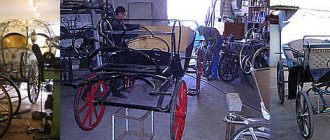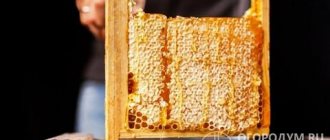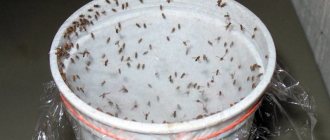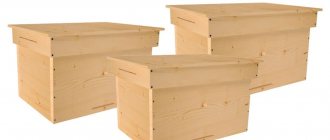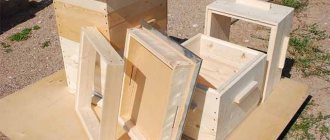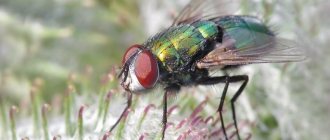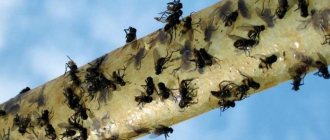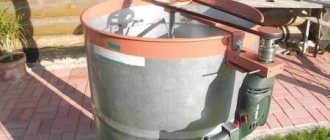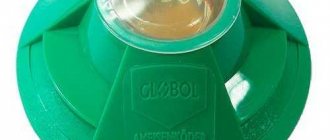Catching swarming bee colonies is a pressing problem both for beginners who are just starting their journey and for experienced beekeepers. For the former, catching wild bees will be a good way to save money; for the latter, it is a way to preserve and increase bee colonies. In the spring, bees begin to swarm and if they are not caught, they can fly outside the apiary, risking leaving the beekeeper with nothing. Approximately once every two years, a new queen appears in the bee colony, which will leave the hive, taking half of the swarm with her, and go in search of a new habitat. Experienced beekeepers anticipate these situations and set traps in time.
Bee traps are used to catch swarms. They are universal, with their help you can catch stray bee families that have not found shelter. Traps are installed near the apiary, or on neutral territory, so that there are no conflicts with other beekeepers. But usually this does not happen, because a wandering swarm that leaves its native apiary is doomed to death and beekeepers do not have conflicts. Also in the forest near ponds, you can catch a wild swarm of bees.
What it is?
In the beekeeping field, traps are various devices made from artificial or natural materials and designed to attract stray/ wild bees. The shape of such traps can be different, but most often they are square or rectangular boxes made of plywood or EPS.
Another do-it-yourself bee trap is often made from a log (the tree species most common in the region is used), then the design is cylindrical in shape. A cavity is created inside the trap for 5 frames , although often the number of frames increases to 6 or even 8 pieces. Thanks to this, the effectiveness of the device significantly increases, because bees, in search of new hives , usually give preference only to the largest objects. Each bait is equipped with only one entrance with a bolt. After insects populate the bait hive, the entrance is closed, and the “captives” are transferred to the apiary .
On a note ! Beekeeping is one of the most ancient economic sectors. Despite the fact that beehives were invented only in the 7th–8th centuries BC, primitive man was also successfully involved honey
Instead of a preface
If this is your first beekeeping season, then for a more complete understanding of the picture, we recommend reading the article “What is bee swarming and how to deal with it”
There is no need to be afraid of swarming. This is not some kind of evil attack or disease, this is a normal phenomenon in the bee colony. It’s somewhat similar to how grown-up children leave their parents’ home. The young swarm flies out of the hive, but will remain nearby for some time. This moment cannot be missed. The beekeeper’s task is to promptly provide the young bee colony with a normal home - a trap. In this way, he will maintain the number of families in the apiary and will not incur additional costs. Believe me, a good, strong family is worth more than a wooden box, which, in essence, is a bee trap. This is a simplified version of a hive for temporary residence.
When the swarm settles into the swarm and more or less calms down, it is moved to a normal, high-quality hive, suitable for wintering.
If you skip swarming, then a new, formed swarm with a young queen will fly away after some time far from the old nest in order to avoid overcrowding and nectar starvation. But if you manage to do everything on time and correctly, then the young bees will mistake the swarmers for their new nest.
Question : Why catch wild swarms?
Answer : how why? To avoid buying new bees. After all, you can catch them for free. Well, it's free of charge. You will spend some money and time on making a bee trap, placing it correctly and checking it periodically. Additional bonus: a good harvest of wild honey. Another reason to use traps to catch wild swarms is to strengthen weak colonies in your apiary.
What’s good about wild swarms is that you don’t have to think about whether they are suitable for a given climate or whether they will work well on the honey plants that are in the area. Wild bees already live in this climate and work on the honey plants that are available. If they are still alive, then everything will be fine when they move to the apiary.
Attention: never move wild swarms to your own immediately after capture. First, treat them against ticks and other diseases if you don’t want to get the whole bunch of troubles for yourself.
Features of making a bee trap with your own hands
You can make bait from almost any material you have at hand. You can also use even a well-dried log for this, as noted earlier, but such work will require first-class carpentry skills and a lot of free time. Therefore, in this article we will look at some of the simplest options.
Before starting work, clearly determine how far the trap will be from the apiary; this distance will affect the size and volume of the structure. If the apiary is located next to meadows or forests, then the bait is made quite large - at least 8 hundred . Such traps are two-tier structures that allow you to catch several bee colonies at once.
If there is no optimal place nearby, the trap is made mobile, on one tier. The small structure can be quickly moved to another location without much effort. It also provides bees with a space of about 50 liters.
Expert opinion
Ponomarev Sergey Stepanovich
Beekeeper with 30 years of experience, Candidate of Technical Sciences
A new colony must be protected from “thieves” from neighboring apiaries, otherwise it may be completely destroyed by a larger bee colony.
Primary requirements
To properly equip a bee bait, you need to comply with certain requirements. The structure is mounted according to the drawing, where everything is indicated in detail. Also, do not forget about the exact dimensions of the bee trap. Otherwise, honey plants will not react to the trap in any way.
Primary requirements:
- The container should hold 40 liters. This is the optimal size.
- The volume of the structure should not exceed 60 liters.
- A vertical device is considered better than a horizontal one. For bees, such buildings resemble a hollow, so they are more willing to fly there.
- The installation material must not contain foreign odors. This will repel insects.
- You can lure insects with fragrant herbs or specially purchased products.
If the beekeeper has no experience, it is recommended to make a simple plywood version. Drawings of a bee trap and optimal sizes are freely available. You can choose the appropriate option for a specific situation.
Plywood trap diagram
Do-it-yourself half-frame trap
Let's start with the fact that a structure of this type does not have a very large volume, but bees, due to their unpretentiousness, will populate it too. the drawings below to create a half- frame
But first, let's talk about what materials are needed.
- The bars are made from any dry and tolerable wood (it can be pine, spruce).
- To make the roof, bottom and walls you will need plywood 4 mm thick.
- The lid additionally needs to be covered with some kind of material to prevent moisture from getting inside the trap. It is better to use thin sheet metal or galvanized steel; polyethylene and roofing felt will last for several seasons, but will cost less.
- The shape of the taphole can be any (or the same as in our drawings).
- Self-tapping screws will also be required to assemble the structure.
- For painting, it is advisable to use acrylic paint (it does not smell and dries quickly enough).
This is a general view of the design of a magazine half-frame .
Assembly drawing of the trap
And this is an assembly drawing of the end of the structure.
Assembly drawing of the end of the trap
The bars in the example have a cross-section of 15x20 mm and different lengths. Before screwing a self-tapping screw into a block, we recommend drilling it with a thin drill first in order to eliminate the risk of splitting.
Drawings for bars for the trap
Bars for the trap
Last fragment of drawings
Plywood, as noted above, should be 4 mm thick. You should not use fiberboard without special protection due to its high hygroscopicity, just like fiberboard or cardboard.
Trap end
Side of the trap
Bottom of the trap
Trap roof
Note ! Such a trap will be cheap. A couple of sheets of plywood are enough for 5 structures. Another similar trap can be used to store magazine frames, or as cores .
Roevnya Butlerova
Roevnya Butlerov is the most popular model of bee trap. It consists of a frame with hoops put on it. To make it you will need the following materials:
- thin plywood (pre-soaked in water for 24 hours);
- staple gun;
- fastening material (bolts, clusters, studs, etc.);
- wire mesh;
- canvas;
- loop, hook or handle.
The height of the scythe will be 400-450 mm, and the diameter will be 300-350 mm.
The process of creating a swarm is as follows:
- Cut a strip of plywood about 1 m long and 40-45 cm wide. This will be the body.
- Cut two strips of plywood 1 m long and about 3 cm wide. These will be hoops.
- The cabinet plywood must be given the shape of a cylinder, and to do this, you need to fix the hoop at the lower base of the future “cylinder” using staples. The hoop strip on one side should be attached at least 5 cm further from the edge, and on the other side it should overlap. Do the same with the hoop at the upper base of the “cylinder”.
- Cover the bottom of the structure with canvas, securing it with staples.
- Prepare another narrow strip of plywood, which you secure with staples along the height of the “cylinder”. The result will be like the handle of a basket (see picture below).
- Cut a strip of plywood for the lid, and secure it with a pin or bolt so that it is movable.
- First, cover the fixed part of the lid with mesh, and then lower the movable part of the lid down and cover it too (as in the figure below).
- Attach a hook or handle to the side of the body so that it is convenient to carry the structure or to hang it on a tree. The handle should be mounted on the opposite side of the movable cover.
DIY trap for 6 Dadan frames
This trap is lightweight, inexpensive and simple in design. swarms large enough to cover 6 Dadan frames.
DIY trap for 6 Dadan frames
What materials will be required to assemble such a trap:
Plywood 4 mm thick
Nails or screws
Bars of different lengths 15x30, 15x20 and 15x15 mm
Tin, galvanized or roofing felt
Anyone can assemble a 6-frame design using the Dadan system without any problems. Among other things, the finished box can be used as an apiary frame for 6 frames.
Look at the general appearance of such a structure.
General view of a 6-frame trap
And this is an assembly drawing of the end. The taphole shape ; in our example, it measures 10x100 mm.
Assembly drawing of the end of the trap
Check out the drawings of the bars. Before screwing a self-tapping screw into a block, we recommend drilling a thin hole in advance to eliminate the risk of splitting the wood.
Drawings of bars for a 6-frame trap
Below are drawings of plywood parts. The required plywood thickness is 4 mm. You should not use fiberboard without a protective coating due to its high hygroscopicity, as well as fiberboard or cardboard.
Drawings of plywood parts
Note ! You should not skimp on material, since high-quality plywood, if painted well on the outside, can last at least 10-12 years.
Varieties
Hive Dadanovsky 12-frame.
In addition to the main types, there are hives:
- Alpine. Does not have a ventilation system or grilles. Consists of several buildings. Doesn't take up much space.
- Dadanovsky. Coniferous trees are used in construction. Widely distributed among other bee dwellings.
- Plywood. Inexpensive option for a house. Construction does not take much time, the service life is long.
- Cassette. This type allows the bees to independently regulate the temperature in the hive. It cannot be painted, it can only be treated with hot wax.
- Plastic. The lightweight design is easily transported from one place to another and does not deteriorate during long-distance transportation. The hermetically sealed walls of the housing do not allow wind and precipitation to pass through. Quickly done with your own hands.
- Northern. The name speaks for itself. The optimal temperature for bees is maintained inside the hive. In the most severe frost, bees do not freeze.
- Asian. Designed for small numbers of bees.
The beekeeper determines which hive is suitable for bees. All types of bee houses can be built with your own hands.
In the drawing of the future bee house, it is necessary to describe the construction technique. In appearance, the hive is similar to human housing. It has a roof and a main frame with an entrance for bees.
It is recommended to make several drawings:
- General. Shows the finished product with dimensions.
- Construction technology.
- Dimensions of individual parts.
- Assembly.
The drawings must show the location of the boundaries between blocks. If it is not possible to make a drawing yourself, you can use the services of builders or experienced beekeepers.
When pumping out honey, you need to be extremely careful not to harm the larvae, otherwise the queen of the hive may sting the beekeeper.
Master Class. An example of making a simple bee trap
Let's consider a budget option for making a trap, which has been done many times and successfully tried.
Simple bee trap
Step 1 . To work, you will need a minimum list of materials and tools. In the example, the author uses unnecessary slats, tape, a jigsaw, garbage bags, a stapler and cardboard boxes.
Step 2 . Then the frame of the structure is assembled. The slats are connected using a stapler.
Step 3 . The frame is covered with cardboard. A frame with wax and old drying material is installed. The frames are fixed with a piece of cardboard.
Step 4 . A garbage bag is pulled over the resulting structure, wrapped with tape, after which a tap hole . Actually, this is where the work ends.
Expert opinion
Ponomarev Sergey Stepanovich
Beekeeper with 30 years of experience, Candidate of Technical Sciences
Under the tap hole on the front wall, the author nailed a piece of old, polarized canvas, using the same stapler.
Plywood roofing
Plywood is ideal for woodworking, as it is an inexpensive, lightweight and durable material. Plywood is an environmentally friendly material; it exists in several types, which differ in thickness, cost and moisture resistance.
To make a plywood frame, you need the following materials:
- plywood;
- metal and mosquito nets;
- wooden block or pressed slabs;
- cardboard;
- waterproof glue;
- scissors;
- woodworking tools.
Roevny dimensions:
- bottom – 35x45 cm;
- side walls (2 pcs.) – 30x45 cm;
- front wall – 35x20 cm;
- cover – 20x45 cm.
There are two ways to make a plywood frame, let’s look at each.
1st method:
- Cut out the pieces.
- Glue them together.
- Make a 1 x 8 cm tap hole on the side wall.
- Make an air exchange frame.
- Place the net on the frame and secure it with shoe nails.
- Make a box from the four walls.
- Attach hangers inside the back and front walls, and bevel the lower part - frames with honeycombs will be placed here.
- Make a hole in the lid, cover it with mesh, and then hang the lid on the latches.
- Attach the hooks on the sides that are needed to hang the bee trap on the tree.
2nd method:
Cut the side slats and frame from 4 cm wide slats.
- Make the folds in the frame necessary to install the frames.
- Cut a 1x1 cm tap hole in the front wall.
- Assemble the side and end walls.
- Secure and tin the roof.
- Set the dryer and at least 5 frames.
- To attract bees to the trap, rub it with wax, propolis or mint.
- Attach the handles.
- If you want the wood to last longer, dry it and paint it. However, this should be done so that all odors have time to dissipate before the trap is used.
In the video below you can see the process of collecting plywood wood:
Where to install the finished trap?
Experienced beekeepers have their own secret places to set traps, almost always guaranteeing the capture of bees. Typically, insects move along safe and long-explored routes, often due to the specific smell of the area, which attracts a swarm. However, for a beginner, choosing a place for a trap is problematic.
When looking for the ideal location, be sure to consider that a swarm often migrates over very long distances in search of housing. He is looking for a place away from competing bee colonies , but at the same time close to flowering vegetation. Therefore, the trap should be placed away from apiaries (at least 3 km).
Baits are also installed outside populated areas: their pollution, electromagnetic radiation and noise usually scare away bees. Do not forget that setting traps near large lakes is also useless, since insects rarely fly into such places.
Important ! The optimal place would be a flowering meadow or an area near forest groves. Ideally, such a site should be located next to a small flowing body of water. When looking for food, bees always visit places that will guarantee their capture.
Tips and Tricks
Collection is only half of successfully catching a swarming bee colony. It is important to place the trap correctly and successfully. Experts advise taking into account the following nuances:
- The optimal height is 6-8 m. However, deviations in this parameter are also allowed.
- The swarm most often settles in strong trunks of conifers, apple trees, pears, acacias, chestnuts and other trees that are known for their lush flowering, as well as under the eaves of a residential building or barn, in a raspberry field. That's why the trap is placed somewhere in such places. This is true for those bee species that do not tend to fly far from their garden plot.
- Power lines should not pass near the location of the box - bees do not like them.
The right time to set a trap
In addition to the appropriate location, it is also worth determining the optimal time to set traps. Often insects leave their homes only once, during the swarming . This process is accompanied by the division of a large swarm into families, which fly away to populate new territories.
This usually happens at the end of May, when many flowering plants appear, it is at this time that we recommend setting traps. There is no point in doing this earlier or with the onset of summer; the chance of catching bees in another period is practically zero, but the risk that they will be spotted by ants, hornets or wasps increases significantly. And expelling them from the house is very problematic.
Traps for stray bees
Lures for catching stray swarms
I have already written about propolis and beeswax. There are also modern baits that are designed specifically for catching swarms. These preparations contain substances that have been selected in accordance with the basic instincts of insects. The most effective baits include the following drugs:
- apimil;
- apira;
- sanroy;
- TOS-3
and others. If you are interested in knowing exactly how they work and what is included in their composition, ask in the comments, I will collect everything I have on them in one article, but for now it is enough to know that they work and apply them correctly.
And here's what happens inside the swarm:
How to catch bees correctly?
Bees are quite whimsical, and therefore it is not easy to lure them to the apiary. They cannot stand artificial odors, but they are attracted to sources of honey and other bee products. Therefore, you need to make bait based on propolis, honey and other things.
Important ! The honeycombs and walls (inside) of the structure should be generously wiped with bee products. You can also additionally use thick sugar syrup by covering the honeycombs with it. Remember that in nature bees live in hollows, so the trap must be fixed at a height of at least 3 m.
Honey
Wax
Propolis
Perga
Finally, we will consider the rules for transferring a hive to an apiary.
- Transfer it in the evening, always after sunset . After all, during the day most insects are outside.
- The trap must be transported immediately . Otherwise, the bees will experience severe stress and most of the swarm may die.
- When working with bees, protect them from strong odors (gasoline, household chemicals, perfume, etc.) . They can make insects angry.
See also : Do-it-yourself hive-bed for 24 frames. In addition, you may be interested in the article about the queen bee.
Rovlya swarms
An apiary is a noble and interesting occupation, but not everyone can take up beekeeping seriously. Proper care of bees is an entire art, which can be truly comprehended even a few years after the purchased layering. At first, incidents happen - the bees develop and reproduce in a completely different way than the beekeeper would like. They can fly away in a swarm, and sometimes more than one, if you do not monitor the development of the bee colony as expected - what to do if this happens?
A special bee trap can help you. The trap, or rather the bait in it, lures your own runaways back home, and with great luck, wild or alien swarms of bees living nearby. Among experienced beekeepers, a very popular hobby is often to lure wild insects into traps, which is not easy to do - you need dexterity, experience, and fearlessness of heights and bees. Young beekeepers should not joke with “savages”.
Arrangement of the Roevny
After the frame of the trap and its main parts have been made, it needs to be painted and filled from the inside to attract bees. Painting and filling the woodwork has its own nuances.
What and how to paint?
There are also several nuances when painting wood:
- Use oil paints for painting. After painting, the trap becomes more resistant to both hot weather, which will save you from premature cracking, and rainy weather, since the paint will prevent the main body of the trap from getting wet. Paint the hive six months before the bees move into it, so that during this time all odors have time to disappear.
- Choose green paint to help the trap blend in with the surrounding trees.
- Do not use quick-drying paints because they retain an unpleasant odor for a long time and quickly become cracked.
- Paint only the outer part of the wall, since the inside should allow moisture and air to pass through and not become covered with condensation due to temperature changes.
Filling the trap
The inside of the swarm also needs to be carefully prepared for the settlement of bees:
- Bees don't like the smell of dry wood. Therefore, to get rid of the smell, expose the roaster with the lid open to the rain.
- To attract the attention of bees, rub the inside of the swarm with lemon balm or blackcurrant leaves;
- hang traps on spruce trees, as they release phytoncides that repel parasites.
- Also rub the heated walls of the trap with broken mother liquors or wax, and coat the edges of the walls with an alcohol solution of propolis.
- Apply a piece of pine resin dissolved in ether to the wooden parts of the frames. After a while, the ether evaporates, but the smell of resin remains.
- Rub the entrance and its edge with wax or honey.
